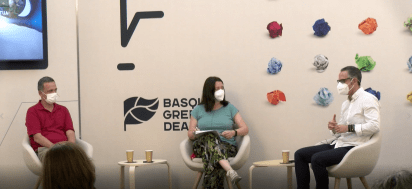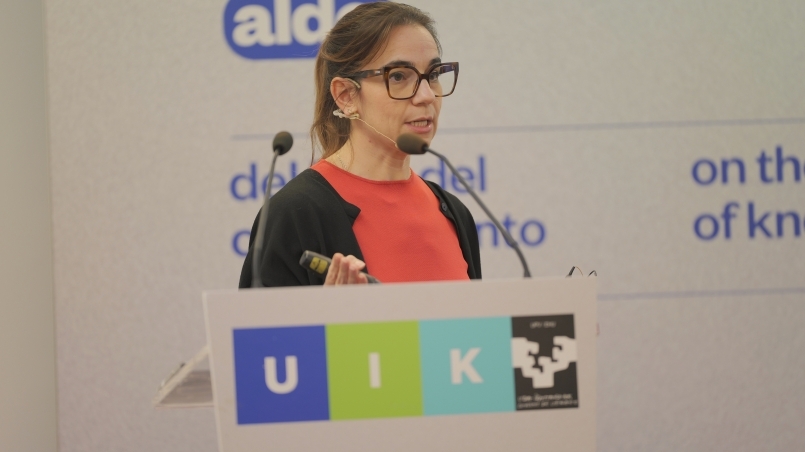Pharmaceutical contamination: the invisible pollution that threatens the environment
<p> The presence of so-called emerging pollutants in the environment is nothing new. Pesticides, pharmaceuticals for human and animal use, cosmetic products, nanoparticles from industrial activities, micro and nanoplastics and illegal drugs often appear in the environment, usually through water pollution, and their effects on ecosystems are just beginning to be studied. </p>

The Donostia Sustainability Forum, within the framework of the Summer Courses of the UPV/EHU, held a conference on June 17 devoted to the analysis of pharmacontamination: the environmental impact of drugs. The guest speakers were Gorka Orive, professor and researcher at the UPV/EHU's Faculty of Pharmacy, and Unax Lertxundi, Head of the Pharmacy Section at Osakidetza's Araba Mental Health Network. Both researchers promote a pioneering innovation program in Alava in the investigation of pharmacontamination and the search for solutions.
Medicines have been and are essential to improve people's quality of life and increase their life expectancy, but their consumption is increasing and they are pollutants of emerging interest due to their effects on the environment and, especially, on animals and plants. It is estimated that around 4,000 different pharmacologically active substances are currently being used in the world, both for human and animal health. According to Unax Lertxundi, the effects on the environment of only one out of every ten drugs are known, which means that we are facing a practically unknown problem, even for health professionals.
According to Gorka Orive, only the tip of the iceberg is known about the drug cycle, since the trail is lost when the drugs are excreted and discharged into wastewater. At present, many of these compounds escape the cleaning technology used in water treatment plants, so they end up in the environment.
So far, residues of more than 700 different drugs have been detected in the environment, mainly in wastewater, rivers and lakes, but also in soil, air and even in tap water. According to a study cited by Unax Lertxundi, tap water in several Spanish cities contains some forty substances from pharmaceuticals. This presence, he added, does not pose a health risk, but must be controlled.
Effects on animals
The effect of hormonal contraceptives on the feminization of fish and amphibians is one of the best known examples of the effects of pharmacontamination in aquatic ecosystems. Another well-known case is the virtual disappearance of three species of vultures in the Indian subcontinent since the early 1990s. Diclofenac in cattle poisoned vulture populations to near extinction. This has become a public health problem in India and Pakistan, where scavenger birds no longer dispose of carcasses. The recent approval of diclofenac in Spain is the cause of the documented death of a vulture in Lleida, as pointed out by Unax Lertxundi.
The effects of pharmacontamination are felt throughout the ecological system in which they are introduced, hence, explained Gorka Orive, that people are already starting to talk about the One Health concept, which links human health to animal and environmental health.
Problems and solutions
Over-prescription and misuse of medicines can intensify the consequences of pharmacontamination, thus the importance of raising awareness of this issue among society in general and the health sector in particular. The Vitoria-Gasteiz City Council, the Provincial Council of Alava, the University of the Basque Country/Euskal Herriko Unibertsitatea, the Bioaraba Health Research Institute, the Vital Foundation, the Official Association of Pharmacists of Alava, BIC Araba, AMVISA and Aquadat signed in February a protocol for the development of an Innovation Program in the field of Pharmacontamination which includes their commitment to research, apply and disseminate solutions in Vitoria-Gasteiz and Araba against the contamination of our environment by drugs.
Among the research to be promoted by Gorka Orive and Unax Lertxundi within the framework of this project is the measurement of the degree of contamination in the Krispiña wastewater treatment plant. The training of health professionals in this area will also materialize with the creation at the UPV / EHU of the first postgraduate degree in pharmacontamination, which will be launched in the 2021-2022 academic year.
Eco-pharmacovigilance
Medicinal products approved for consumption in the European Union have been required to submit an environmental impact report since 2005. However, to date, this is merely an informative report. This, Unax Lertxundi added, could change in the future. It cannot be ruled out that drugs could be withdrawn from the market because of their impact on the environment, leading to the creation of a new concept: eco-pharmacovigilance. In any case, these should be drugs that can be substituted by others since, as Gorka Orive pointed out, protecting health must be a priority.


